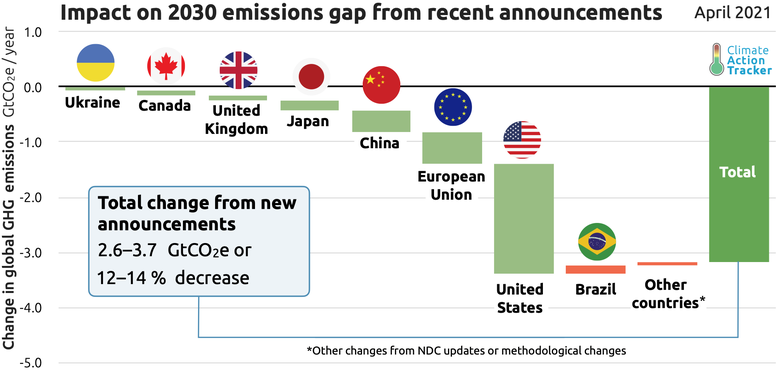New momentum reduces emissions gap, but huge gap remains - analysis
Press release
Yesterday’s climate action announcements at US President Biden’s Leaders’ Summit on Climate, together with those announced since September last year, have narrowed the 2030 emissions gap by around 12-14% (2.6-3.7 GtCO2e), according to a provisional post-Summit analysis by the Climate Action Tracker. The largest contributions came from the US, the EU+UK, China and Japan.
At the first day of the Summit, the Prime Ministers of Japan and Canada announced new climate targets, while the Biden Administration submitted its new Nationally Determined Contribution (NDC) to the UNFCCC, taking the biggest climate step made by any US government in history.
“It’s clear the US is back in the climate game, and, for the first time, is lining up to be a leader." said Niklas Höhne, of NewClimate Institute, a CAT partner organisation.
"With other big emitters like Japan, the EU and the UK also stepping up, we are now starting to see the kind of near-term climate action the world needs to win the race to zero by 2050, and keep warming to 1.5ºC. While the gap is still huge, the summit created new momentum.”
“President Biden’s summit has led to the single biggest reduction in the 2030 emissions gap - at 12-14% - that we’ve ever seen, and has also reinforced the centrality of the 1.5°C limit in the Paris agreement as a global goal," said Bill Hare of Climate Analytics, the other CAT partner.
"China’s announcement that it will peak coal by 2025 and begin reductions afterwards is welcome news. It is now up to the rest of the world to revisit - and increase - their 2030 targets. Some governments, notably Australia, have not announced any new targets at all, which can be seen as a direct repudiation of the Paris Agreement.
“The next step is to see governments implement policies to actually meet their new targets. This will be the real test.”
President Biden announced an ambitious new 2030 target of 50-52% below 2005 levels, a significant step forward, but falls short of the 57-63% below 2005 levels needed to be compatible with the Paris Agreement’s 1.5ºC temperature limit and promised to increase US support for developing countries.
The Canadian and Japanese Prime Ministers also announced new targets at the Summit, building on the those already announced by the EU, China, the UK and others last year, although China, Canada and Japan have not yet officially submitted their new targets to the UN. South Korea also pledged to submit a revised target later this year and committed to ending all public financing for coal-fired power plants overseas. Overall, there are signs of more ambitious targets than we have seen in the first round of NDC updates, particularly from the bigger emitters.
China announced plans to strictly control coal consumption over the next 14th Five-year Plan period (FYP 2021-2025) and to start gradually phasing out coal during the 15th FYP (2026-2030). While restraining the coal industry is a continuation of current policy priorities, this is the first time China has announced a timeframe for the peaking of coal. This should be considered a significant milestone. Importantly, however, the commitment does not include placing an absolute limit on coal growth in the next five years, or an actual date for a complete coal phase-out, nor ending financing of fossil fuel infrastructure abroad.
A number of G20 countries are still missing in action or have even backtracked on commitments:
- Australia did not announce stronger 2030 targets, referencing only a preference to reach to net zero at an unspecified date depending upon technology development.
- Brazil’s President Bolsonaro did not announce a stronger 2030 target, but brought forward the country’s climate neutrality goal by 10 years from 2060 to 2050. Changes in the baseline of the Brazilian 2030 target made earlier this year, which effectively weakens the target, casting a shadow over the sincerity of this revised climate neutrality pledge.
- Mexico has weakened its target and promised to continue oil exploration.
- India also did not announce any new target, but rather reiterated its 2030 renewable energy target.
- Turkey reiterated its old target and has yet to ratify the Paris Agreement.
The Climate Action Tracker will release its full assessment of the Summit’s impact on both the emissions gap and end of century warming the week beginning 3 May 2021.
Stay informed
Subscribe to our newsletter


